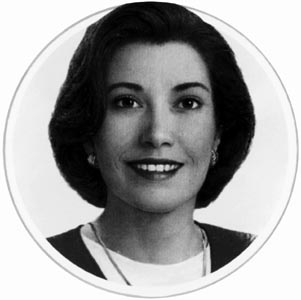![[Metroactive News&Issues]](http://metroactive.com/gifs/news468.gif)
[ San Jose | Metroactive Central | Archives ]
Deconstructing Betty
Latest incarnation of a helpful homemaker takes the cake
By J. Douglas Allen-Taylor
A STRANGE THING HAPPENED the other day: Betty Crocker sent a postcard to our newsroom. The cake-mix lady who used to saunter through kitchens in a June Cleaver dress and apron, wielding a wooden spoon, says she's writing a newspaper column now and has her own radio program. She'd even like to answer email questions about all aspects of the subject of food, from what to put in a stuffed artichoke to the best way to preserve a batch of leftovers. She thoughtfully sends her own portrait, though she looks a little darker and a little younger than I remembered. Seeing as how it took many hours of childhood struggle to come to the conclusion that Betty Crocker was only the product of someone's imagination, I find my mind messed up all over again. If she's not real, who's signing her mail? And who is that lady with the smooth bob and the business attire in the picture on her postcard?
For those of you who have not been eating in the past 70 years or so, Betty Crocker is the symbol for a long line of foodstuffs and bestselling recipe books from General Mills Foods.
Along with Aunt Jemima and Uncle Ben, Betty Crocker was a living presence in mom's kitchen during the growing up years of boomers and ex-ers, and why not? All those happy faces grinned from their convenient product packages on our shelves. While my mother mixed a bowl of white frosting, I knew that in another kitchen in Middle America somewhere, a smiling, middle-aged white lady was patiently doing the same thing, trying to make the next box a little better for us.
This is not especially unusual, since I was a child who argued that Tarzan really could swing from vines, and searched the maps of the family atlas for the Deadly Desert that marked the boundaries of Oz. When my sister broke the news that Miss Betty was just an advertising concoction, I was crushed. But now that the lady is back answering letters, I am not so sure.
And anyway, why should that be so astounding? It turns out there never was an actual Aunt Jemima with any interest in pancakes, either. According to the St. Joseph [Missouri] News-Press, it was the name of a song done by a black St. Joseph vaudeville singer who performed in an apron and red bandanna. The founder of the company saw the show and stuck her up on his boxes. But Uncle Ben was real enough. The company's website says he was an African American rice farmer "known to rice millers in and around Houston for consistently producing the highest quality rice. It was said that Uncle Ben harvested his rice with such care that he repeatedly received honors for full kernel yields and quality." (Not good enough to be invited into the business of instant rice, however. The website goes on to explain that "the details of Uncle Ben, the quality rice farmer, are lost to history.") There really was a Colonel Harlan Sanders, too, although he died in 1980. Whoever stands there in his suit in the television commercials is anyone's guess.
Of course, if Betty Crocker is really alive, she's got a touch of Dorian Gray about her. In her latest portrait she appears about 10 to 15 years younger than the dour, pursed-lipped lady who first appeared in a 1921 artist's rendition. She's gone through six progressively younger and more feminist incarnations since then. According to the online Collegiate Times (www.ctonline.org): "When first conceived she was designed to suggest a woman of the 1920s, dealing with Roaring Twenties' new technology. Her 1955 make-over appealed to the mother figure of the new brides. Ten years later we were given 'Power Betty.' The sixties Betty was confident, playing on the feelings of the time." The changes were so profound that a Minnesota museum once put on a Mother's Day exhibit made up of just the various changing Crocker portraits.
The new Betty, according to the Collegiate Times, "reflect[s] the browning of America. ... Brown eyes replace the euro-centric blue. Her face is a morphing of 75 females of all racial backgrounds that melts to a gentle hue of cinnamon." The Washington Post calls her "multicultural, a little more whole wheat than white bread."
The communications director for General Mills told the Baltimore Sun that the new Betty is "much more ethnically diverse. ... She is intended to represent the women of America, and a lot has changed about women in America since the last portrait was done."
Of course, if Betty has gained the brownskinned look of the new millennium, she hasn't given up all of her mid-20th-century views. Among other "Inspirational Tips & Bettyisms" listed on the official Betty Crocker website (www.bettycrocker.com) she offers: "You can search far and wide for what you need, only to find it waiting at home," and "I can't think of a more rewarding goal in life than simply to be happy at home."
So is Betty Crocker real? When asked, the folks at General Mills play the Clinton card. "Depends on what you mean by 'real.' As a symbol for quality products, creative recipes and reliable advice, no one is more authentic than Betty. ... Now, is Betty Crocker an actual person? Well, we like to think there's a little bit of Betty in all of us. What do you think?"
[ San Jose | Metroactive Central | Archives ]
Copyright © 1999 Metro Publishing Inc. Metroactive is affiliated with the Boulevards Network.
For more information about the San Jose/Silicon Valley area, visit sanjose.com.
![]()

From the August 12-18, 1999 issue of Metro, Silicon Valley's Weekly Newspaper.